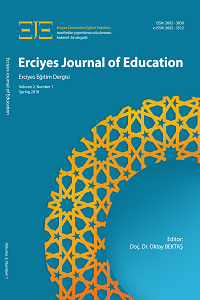Haydarâbâd Salar Jung Kütüphanesindeki Türkçe Öğretimi İle İlgili Yazma Eserler ve Bu Eserlerden Fazlullah Han Barlas Tarafından Yazılan “Lugat-ı Türkî”nin Çağatay Türkçesi Öğretimi Yöntemine Dâir Düşünceler
Öz
Hindistan’ın
büyük müze-kütüphanelerinden biri olan Salar Jung’da yaptığımız çalışmalarda,
yirmi altı adet Türkçe/Çağatay Türkçesi eser tespit edilmiştir. Genellikle dil
ve edebiyat üzerine olan bu eserlerin sekiz tanesi doğrudan dil öğretimi ile
ilgilidir. Sekiz eserden yedisi Türkçe öğretmek biri de Farsça öğretmek
amacıyla yazılmıştır.
Bu yazıda söz
konusu eserlerden önce birkaç sayfa orijinal metin görüntüleri verilerek nüsha
tavsifi yapılmış ve sonrasında eserlerin muhtevasından kısaca bahsedilerek
Türkçe öğretim yöntemlerine değinilmiştir. Çağatay Türkçesi öğretmek amacıyla
Fazlullah Han Barlas tarafından 18. yüzyılda yazılan “Lugat-ı Türkî” adlı
eserin ise, kütüphanede yaptığımız inceleme notlarımız ve elimizdeki dijital
görüntüler imkânında, muhtevası ve Çağatay Türkçesi öğretimi yöntemine dâir
örneklerle daha ayrıntılı açıklamalar yapılmaya çalışılmıştır.
İncelediğimiz bu
eserlerin, hazırlanış yöntemlerine göre, gramer-sözlük,
gramer ve sözlük, sadece gramer ve sadece sözlük şeklinde tasnif edilebileceği sonucuna varılmıştır.
İki dilli
öğretim yönteminin kullanıldığı bu eserlerin altısında Farsça ile Türkçe
öğretmek, birinde Arapça ile Türkçe öğretmek ve birinde de Türkçe ile Farsça
öğretmek amaçlanmıştır. Bunların bazısı manzum olarak yazılmış, mensur
olanlarda da nazma benzer bir format tercih edilmiştir. Bu da dil öğretiminde
genellikle ezber yönteminin ön
planda tutulduğunu göstermektedir.
Anahtar Kelimeler
Kaynakça
- ATEŞ, Ahmet (1940-1942). “Metin Tenkidi Hakkında (Dasitân-ı Tevârih-i Mülûk-i Âl-i Osman Münasebeti ile)”, Türkiyat Mecmuası, c. VII-VIII, 1940-1942, s. 253- 267.BİLKAN, Ali Fuat (1998). Hindistan’da Gelişen Türk Edebiyatı, Kültür Bakanlığı Yayınları, Ankara.KAVAKÇI, Yusuf Ziya (1982). İslam Araştırmalarında Usûl, Diyanet İşleri Başkanlığı Yayınları, Ankara.YAZIR, Mahmud Bedreddin (1981). Medeniyet Âleminde Yazı ve İslâm Medeniyetinde Kalem Güzeli, Diyanet İşleri Başkanlığı Yayınları, Ankara.
Manuscripts Related to Teaching Turkish in Hyderabad Salar Jung Library and Thoughts Towards Chagatai Turkish Teaching Methods in “Lugat-ı Türkî” Written by Fazlallah Han Barlas
Öz
Twenty-six Turkish writing works have been identified as a result of the research
that we personally conducted at the SalarJung Library in Hyderabad province of
India. Eight of these relate directly to language teaching, and grammaticaldictionary,
grammar and dictionary, aimed at teaching language only through
grammar and dictionary method only. There are dictionary and dictionarygrammars
which are prepared as verse in them, as well as those who have close
formations. This shows that these works are based on the method of memorizing
in language teaching. Moreover, these works are based on bilingual teaching
method. Six of the eight works were written to teach Turkish with Persian, one to
teach Turkish with Arabic and one to teach Persian with Turkish. Because most of
these works we have studied are dictionary logic, someone who speaks Turkish
can learn Farsi in this way. This also applies to other works written in ArabicTurkish
or Turkish-Persian.
We tried to describe these works and learn about their contents in the context of
our personal work in the library. Moreover, although we wanted to receive the
digital images of writing in Turkish, on condition that it was received in tribal
terms, it was not allowed to take the full image of the works because of the difficult
and intricate bureaucracy of India. However, it was possible for us to get only a
few pages of images from each work as a result of our insistence on the library
authorities. In our article, samples were given from the images we can get.
This article has been considered as the first and main article for the introduction
of 8 works in the Indian Salar Jung Library in the teaching of Turkish. Because
here, seven of the eight works will be discussed and briefly discussed, and one's
content and language teaching method will be examined in detail. As long as we
have the opportunity, the remaining 7 works will be examined by individual
articles and individual content and language teaching methods.
Anahtar Kelimeler
İndia Library of Salar Jung teaching Turkish manuscript Fazlullah Han Barlas Lugat-ı Turkî
Kaynakça
- ATEŞ, Ahmet (1940-1942). “Metin Tenkidi Hakkında (Dasitân-ı Tevârih-i Mülûk-i Âl-i Osman Münasebeti ile)”, Türkiyat Mecmuası, c. VII-VIII, 1940-1942, s. 253- 267.BİLKAN, Ali Fuat (1998). Hindistan’da Gelişen Türk Edebiyatı, Kültür Bakanlığı Yayınları, Ankara.KAVAKÇI, Yusuf Ziya (1982). İslam Araştırmalarında Usûl, Diyanet İşleri Başkanlığı Yayınları, Ankara.YAZIR, Mahmud Bedreddin (1981). Medeniyet Âleminde Yazı ve İslâm Medeniyetinde Kalem Güzeli, Diyanet İşleri Başkanlığı Yayınları, Ankara.
Ayrıntılar
| Birincil Dil | Türkçe |
|---|---|
| Konular | Eğitim Üzerine Çalışmalar |
| Bölüm | Araştırma Makalesi |
| Yazarlar | |
| Yayımlanma Tarihi | 2 Haziran 2018 |
| Gönderilme Tarihi | 23 Mayıs 2018 |
| Kabul Tarihi | 30 Mayıs 2018 |
| Yayımlandığı Sayı | Yıl 2018 Cilt: 2 Sayı: 1 |
Kaynak Göster
ERCİYES JOURNAL OF EDUCATION [EJE]
 This work is licensed under a Creative Commons Attribution 4.0 International License.
This work is licensed under a Creative Commons Attribution 4.0 International License.




